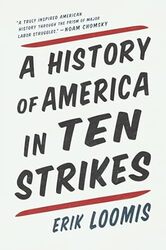
Rating: 7.8/10.
Book about strikes, unions, and labor movements throughout US history. The dynamics and expectations of the working class have changed significantly, but a common theme that occurs throughout history is that the role of government is crucial: if the government decides to side with employers to destroy unions, there is generally nothing that workers can do.
The first unions and strikes in America appeared soon after the Industrial Revolution, when workers at textile factories and mills protested for working no more than 10 hours a day, shorter Saturdays, etc. They sometimes succeeded but often failed when employers hired more desperate Irish immigrants or convinced the unions to dissolve as part of negotiations.
During the era of slavery, slaves often rebelled individually against harsh treatment, but they were unable to organize. After the Civil War, many whites still expected similar types of slave labor from blacks, who sometimes organized and went on strike as they took more control over their lives. However, they faced significant resistance from white authorities who responded with violence to deal with striking workers.
During the Gilded Age prior to 1900, America experienced some of the most unequal conditions in its history, where factory and railroad workers often went on strike and argued for eight-hour workdays but were routinely met with violence. As a last resort, the government consistently sided with employers and often brought in the military to break up strikes. Around 1900, however, the government realized its power to side with either owners or workers and no longer consistently sided with owners. Examples include Roosevelt deciding to negotiate discussions between strike leaders and owners rather than simply putting down strikes for the owners. In other cases, brutal actions against striking workers radicalized them, leading to the bombing of government buildings and forcing the government to step in and order the two sides to mediate.
The Industrial Workers of the World (IWW), also known as the Wobblies, had some success in organizing strikes in the 1900s and 1910s but faced several drawbacks. First, their leaders prioritized radical ideology instead of practical workers’ concerns and often advocated for violence, even though they never followed through with any of it. Their words would be turned against them, and they would move to different struggles after any kind of victory, which made their gains short-lived. Overall, they failed to achieve the type of worker revolution they were aiming for.
During the 1930s, Roosevelt was considerably more supportive of worker rights and unions than his predecessors, and strikers developed new tactics. Automobile factory workers in Flint organized a sit-down strike in the factory to prevent employers from using violence that would destroy machines or from calling in strike breakers, which largely worked because the government recognized unions as legitimate.
In the 1940s, many unions experienced internal conflicts, such as misalignment between racial groups or between men and women. The 1946 Oakland General Strike was an exception where most of the city organized a strike together. In the 1950s, the government maintained a friendly stance towards unions, and with sufficient economic growth, the working class made significant gains in conditions and wages.
In the 1960s, younger workers demanded more from their jobs and were unhappy about their lifetime of work on the assembly line. Auto workers in Lordstown, Ohio began protesting working conditions and the pace of work. At this time, the American economy was stalling, and many were laid off as manufacturers chose to move overseas rather than deal with unions. Workers and unions were forced to roll back many of their previous gains.
The government’s attitude toward unions drastically shifted under President Reagan, as exemplified by the PATCO air traffic controller strike in the 1980s. While the union was initially able to leverage their position and get what they wanted from the government by shutting down airports, they eventually lost public support since they were already paid more than average workers. Reagan fought back by hiring replacement workers, and many strikers were fired and banned from government work for life. Other industries, like mining, suffered similar defeats as the government used its power to weaken unions, especially since trade with Mexico and other countries made it much easier to move manufacturing overseas.
In the 1990s, economic struggles in Latin America led to a large number of undocumented migrants who were eager to fill labor roles. These workers were afraid to strike or join unions, though one notable strike in LA involving janitors gained a lot of attention when police beat up the migrant workers. These cases were rare since, after Reagan, the government has generally sided with corporations to break up unions and limit their power, finding less overt ways of doing so that did not attract as much negative attention. As a result, unions today are much weaker than in the decades before Reagan. Finally, the author laments the election of Trump in 2016, who ran on racist rhetoric, rather than Bernie Sanders, who truly represents the working class.
Overall, this book gives a comprehensive history on this topic with well-researched events, and how issues and government attitudes changed throughout the years. It focuses specifically on America, and while the writing style is quite academic, it’s a reasonable introduction to this topic.



